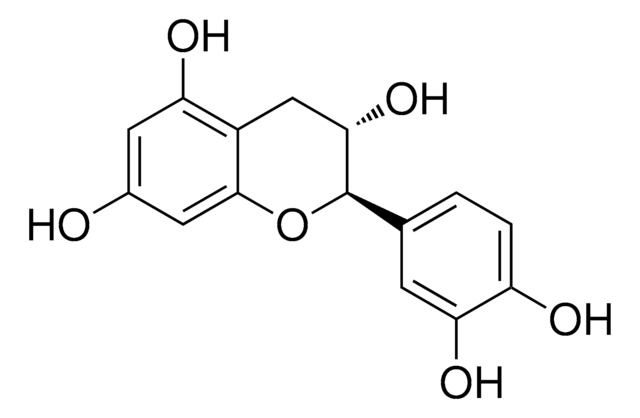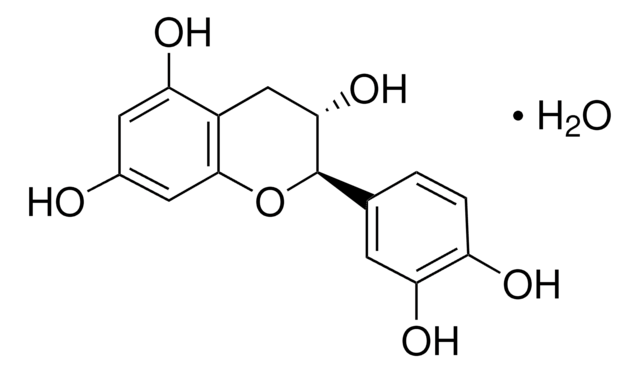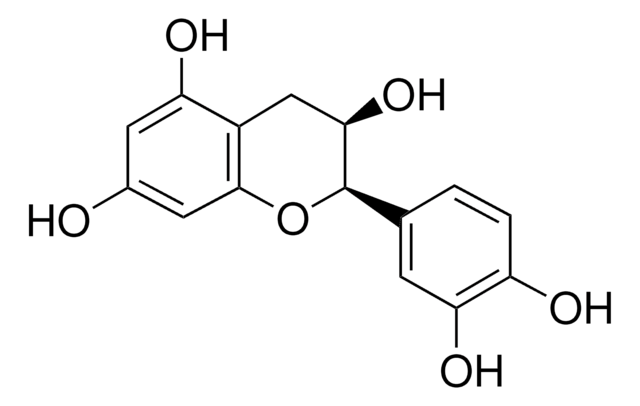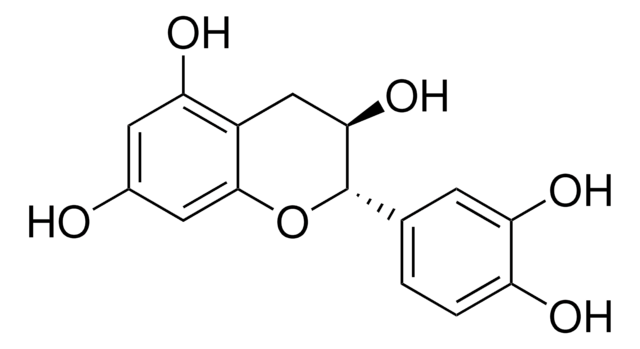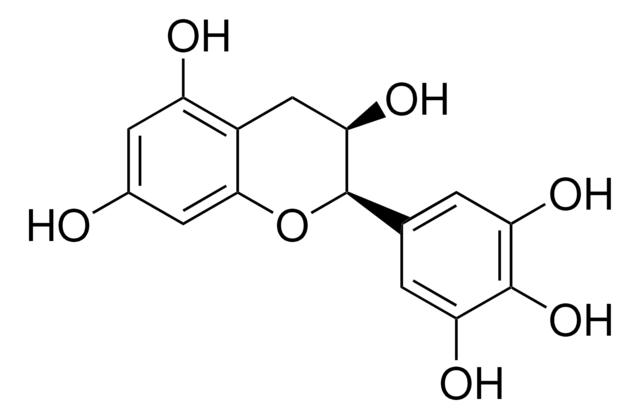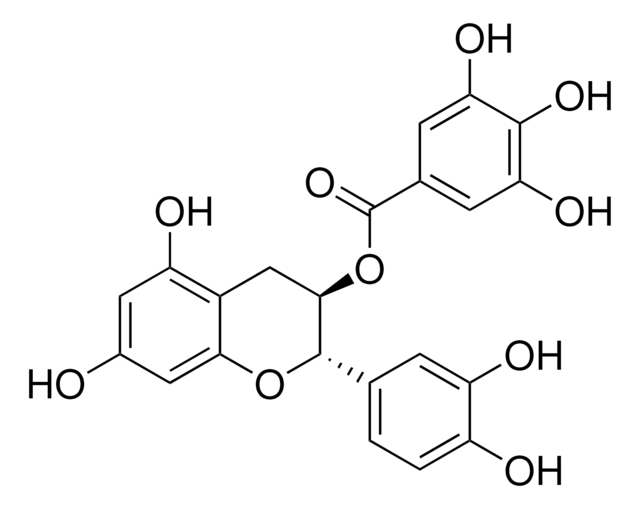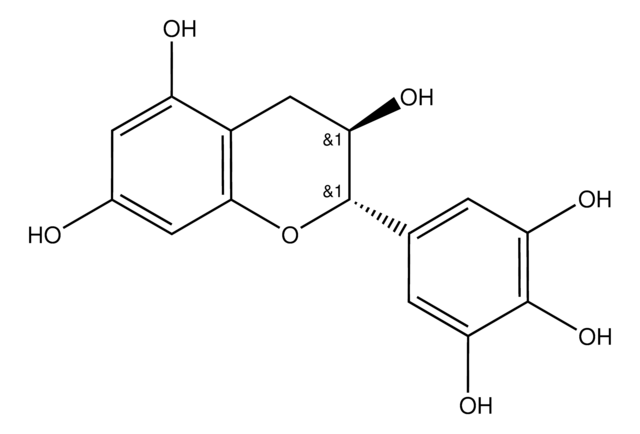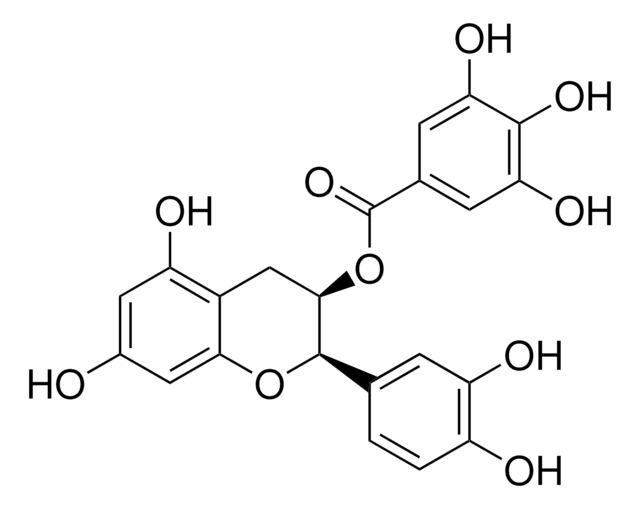43412
(+)-Catechin
analytical standard
Sinonimo/i:
(+)-Cyanidanol, D-Catechin
About This Item
Prodotti consigliati
Grado
analytical standard
Livello qualitativo
Saggio
≥99.0% (HPLC)
Durata
limited shelf life, expiry date on the label
tecniche
HPLC: suitable
gas chromatography (GC): suitable
applicazioni
food and beverages
Formato
neat
Temperatura di conservazione
2-8°C
Stringa SMILE
O[C@H]1Cc2c(O)cc(O)cc2O[C@@H]1c3ccc(O)c(O)c3
InChI
1S/C15H14O6/c16-8-4-11(18)9-6-13(20)15(21-14(9)5-8)7-1-2-10(17)12(19)3-7/h1-5,13,15-20H,6H2/t13-,15+/m0/s1
PFTAWBLQPZVEMU-DZGCQCFKSA-N
Cerchi prodotti simili? Visita Guida al confronto tra prodotti
Descrizione generale
Applicazioni
- Method development for the multi-determination of catechin and its diastereomers in the leaf extracts and infusions obtained from five Byrsonima species using high-performance liquid chromatography, combined with photodiode array (PAD) and circular dichroism (CD) detectors
- Determination of catechin in commercial green and black tea samples using magnetic solid phase extraction (MSPE) based on a novel adsorbent— O-carboxymethyl-chitosan-g- acrylic acid sodium salt (O-CMCs-g-AAS) copolymer deposited on magnetic graphene oxide (MGO), for sample pre-treatment and gas chromatography-mass spectrometry (GC-MS)
- Multi-residue analysis of eight catechins and four theaflavins in three different commercial tea infusions (green, black, and oolong) by ultra high-performance liquid chromatography in combination with triple-quadrupole tandem mass spectrometry (UHPLC-MS-MS)
- Simultaneous detection and quantification of four phenolic compounds— catechin, caffeic acid, rutin, and trans-cinnamic acid, using ultrasonic-assisted extraction and HPLC coupled with diode array detection from Physalis angulata L. plant material samples
- Multi-residue determination of catechins, caffeine, and polyphenols, from 45 fresh Jukro tea leaf samples, collected at 40, 60, and 90-day intervals, by an HPLC-based method combined with PDA detection
Confezionamento
Avvertenze
Warning
Indicazioni di pericolo
Consigli di prudenza
Classi di pericolo
Eye Irrit. 2 - Skin Irrit. 2 - STOT SE 3
Organi bersaglio
Respiratory system
Codice della classe di stoccaggio
11 - Combustible Solids
Classe di pericolosità dell'acqua (WGK)
WGK 3
Punto d’infiammabilità (°F)
Not applicable
Punto d’infiammabilità (°C)
Not applicable
Scegli una delle versioni più recenti:
Possiedi già questo prodotto?
I documenti relativi ai prodotti acquistati recentemente sono disponibili nell’Archivio dei documenti.
I clienti hanno visto anche
Protocolli
HPLC Analysis of Polyphenols in Nero d'Avola Red Wine on Discovery® HS C18 (UV 280 nm)
Coumaric acid; Quercitrin; Myricetin; Quercetin
Il team dei nostri ricercatori vanta grande esperienza in tutte le aree della ricerca quali Life Science, scienza dei materiali, sintesi chimica, cromatografia, discipline analitiche, ecc..
Contatta l'Assistenza Tecnica.